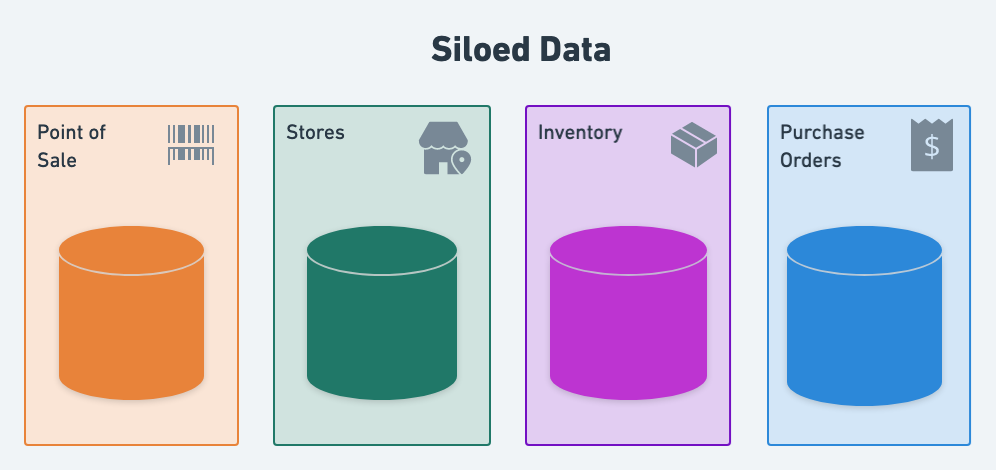
Just like with customer data, siloed product data can cause major headaches. Tracking products across franchises, branches, international brands and warehouses is extremely challenging, even when operations are well-organised.
Getting it together
Just like with customer data, siloed product data can cause major headaches. Tracking products across franchises, branches, international brands and warehouses is extremely challenging, even when operations are well-organised.
Product data is essential to operations. When the data is collected and stored individually across each arm of the business (siloed), reporting has to be done by each branch manually and then manually aggregated. Productivity suffers and decisions made based on this data are out of date by the time they are implemented.
The structure usually looks something like this.

Get ready to see you inventory clearly
To solve this problem, three key strategies have to be employed.
1. Data integration
All the data needs to be in one place. Every store inventory, warehouse inventory and online product list needs to be visible in one place.
This means pipelines need to be built to ingest data from each individual source to funnel it to one centralised data store (e.g. data warehouse or data lake). This is a prerequisite to accessing a holistic view of the state of product within the business.
2. Data governance
Data needs be reliable, clean and uncorrupted to be of value. Governance is important because it ensures that once data is extracted from the source that provided it, the rules and details of the data are enforced at the time of ingestion into the centralised data store.
Beyond that, a Data Catalogue is essential to be created and kept up-to-date throughout the entire process. It allows self-service across teams, and reduces the need for back-and-forth on data definitions.
Good data governance makes data easy to use and share.
3. Modernising business intelligence (BI)
Business intelligence has always been an essential part of any modern business. Usually, when data is siloed, BI tends to also be siloed and only applicable to the teams that source the data.
Changing the approach to a comprehensive view of product and inventory is difficult, when each team has their own approach.
A solid data backbone that allows quick and robust integrations plus storage, allowing BI to be readily accessible across teams. It breaks down barriers between teams, allowing for better, more effective insight and self-service. Teams no longer have to wait for each other for manual reporting or question whether the data is up-to-date and valid.
Achieving advance capabilities
Providing unified product data, enables advanced business capabilities, including:
Optimise product movement
A high level view of all stock-in-place gives a clear picture of opportunities for the movement and management of stock. Get your products where you need them most with ease.
Real-time fulfilment and inventory dashboards
Know the true state of all your product holdings across multiple sites at all times. A centralised data store can have a dashboard layered on top, with data updated as quickly as data integrations allow.
Assess stock levels and seasonal readiness
Visualise your historical sales data across the whole business and plan for seasonal sales, promotions and special stock requirements. See historical trends and plan accordingly.
Predict and prepare for demand
Tracking the stock flow over time, allows for a historical picture of key points of demand. By employing machine learning algorithms, seasonal and non-seasonal trends and patterns can identify opportunities automatically. This means you can put stock where it’s likely to be needed, when it’s likely to be needed.

